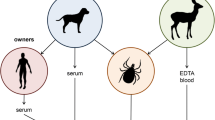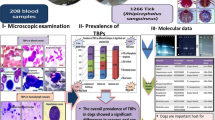Abstract
In this study, we have analyzed the intestinal microbial flora associated with Rhipicephalus microplus ticks using both culture-dependent and independent methods based on PCR and denaturing gradient gel electrophoresis (PCR–DGGE). The R. microplus ticks were collected from cattle and goats in Jiangxi, Hunan and Guizhou Provinces of China. Three distinct strains of bacteria were isolated using culture-dependent methods: Staphylococcus simulans, Bacillus subtilis and Bacillus flexus strain. Nineteen distinct DGGE bands were found using PCR–DGGE analysis, and their search for identity shows that they belonged to Rickettsiaceae, Xanthomonadaceae, Coxiella sp., Ehrlichia sp., Pseudomonas sp., Ehrlichia sp., Orphnebius sp., Rickettsia peacockii, Bacillus flexus. Rickettsia peacockii and Coxiella genus were the dominant strain of the R. microplus ticks from cattle, Pseudomonas sp. and B. flexus strain were the most common species in all tick samples from goats. Ehrlichia canis were detected only in R. microplus ticks from Yongshun area in Hunan Province. The results indicate that the intestinal microbial diversity of R. microplus ticks was influenced by tick hosts and local differences in the sampling location and these two aspects may affect transmission of pathogen to humans and animals.




Similar content being viewed by others
References
Ahantarig A, Trinachartvanit W, Baimai V, Grubhoffer L (2013) Hard ticks and their bacterial endosymbionts (or would be pathogens). Folia Microbiol 58:419–428
Alessandra T, Santo C (2012) Tick-borne diseases in sheep and goats: clinical and diagnostic aspects. Small Ruminant Res 106:S6–S11
Ariefdjohan MW, Savaiano DA, Nakatsu CH (2010) Comparison of DNA extraction kits for PCR–DGGE analysis of human intestinal microbial communities from fecal specimens. Nutr J 9:23
Egyed L, Makrai L (2014) Cultivable internal bacterial flora of ticks isolated in Hungary. Exp Appl Acarol 63:107–122
Halos L, Mavris M, Vourch G, Maillard R, Barnouin J, Boulouis HJ, Vayssier-Taussat M (2006) Broad-range PCR–TTGE for the first-line detection of bacterial pathogen DNA in ticks. Vet Res 37:245–253
Kittelmann S, Janssen PH (2011) Characterization of rumen ciliate community composition in domestic sheep, deer, and cattle, feeding on varying diets, by means of PCR–DGGE and clone libraries. FEMS Microbial Ecol 75:468–481
Kušar D, Avguštin G (2012) Optimization of the DGGE band identification method. Folia Microbiol 57:301–306
Li S, Sun L, Wu H, Hu Z, Liu W, Li Y, Wen X (2012a) The intestinal microbial diversity in mud crab (Scylla paramamosain) as determined by PCR–DGGE and clone library analysis. J Appl Microbiol 113:1341–1351
Li X, Nan X, Wei C, He H (2012b) The gut bacteria associated with Camponotus japonicus Mayr with culture-dependent and DGGE methods. Curr Microbiol 65:610–616
Maia C, Ferreira A, Nunes M, Vieira ML, Campino L, Cardoso L (2014) Molecular detection of bacterial and parasitic pathogens in hard ticks from Portugal. Ticks Tick Borne Dis 5:409–414
Moreno CX, Moy F, Daniels TJ, Godfrey HP, Cabello FC (2006) Molecular analysis of microbial communities identified in different developmental stages of Ixodes scapularis ticks from Westchester and Dutchess Counties, New York. Environ Microbiol 8:761–772
Murrell A, Dobson SJ, Yang X, Lacey E, Barker SC (2003) A survey of bacterial diversity in ticks, lice and fleas from Australia. Parasitol Res 89:326–334
Narasimhan S, Rajeevan N, Liu L, Zhao YO, Heisig J, Pan J, Eppler-Epstein R, Deponte K, Fish D, Fikrig E (2014) Gut microbiota of the tick vector Ixodes scapularis modulate colonization of the Lyme disease spirochete. Cell Host Microbe 15:58–71
Oteo JA, Portillo A (2012) Tick-borne rickettsioses in Europe. Ticks Tick Borne Dis 3:271–278
Rudolf I, Mendel J, Šikutová S, Svec P, Masaríková J, Nováková D, Bunková L, Sedlácek I, Hubálek Z (2009) 16S rRNA gene-based identification of cultured bacterial flora from host-seeking Ixodes ricinus, Dermacentor reticulatus and Haemaphysalis concinna ticks, vectors of vertebrate pathogens. Folia Microbiol 54:419–428
Schabereiter GC, Lubitz W, Rölleke S (2003) Application of broad-range 16S rRNA PCR amplification and DGGE fingerprinting for detection of tick-infecting bacteria. J Microbiol Methods 52:251–260
Theron J, Cloete TE (2000) Molecular techniques for determining microbial diversity and community structure in natural environments. Crit Rev Microbiol 26:37–57
Tveten AK (2013) Prevalence of Borrelia burgdorferi sensu stricto, Borrelia afzelii, Borrelia garinii, and Borrelia valaisiana in Ixodes ricinus ticks from the northwest of Norway. Scand J Infect Dis 45:681–687
Tveten AK, Sjåstad KK (2011) Identification of bacteria infecting Ixodes ricinus ticks by 16S rDNA amplification and denaturing gradient gel electrophoresis. Vector Borne Zoonotic Dis 11:1329–1334
Tveten AK, Riborg A, Vadseth HT (2013) DGGE identification of microorganisms associated with Borrelia burgdorferi Sensu Lato-or Anaplasma phagocytophilum-infected Ixodes ricinus ticks from northwest Norway. Int J Microbiol 2013:805456
Van Overbeek L, Gassner F, Van Der Plas CL, Kastelein P, Nunes-da Rocha U, Takken W (2008) Diversity of Ixodes ricinus tick-associated bacterial communities from different forests. FEMS Microbiol Ecol 66:72–84
Vayssier-Taussat M, Moutailler S, Michelet L, Devillers E, Bonnet S, Cheval J, Hébert C, Eloit M (2013) Next generation sequencing uncovers unexpected bacterial pathogens in ticks in western Europe. PLoS ONE 8:e81439
Wielinga PR, Gaasenbeek C, Fonville M, de Boer A, de Vries A, Dimmers W, Akkerhuis Op Jagers G, Schouls LM, Borgsteede F, van der Giessen JW (2006) Longitudinal analysis of tick densities and Borrelia, Anaplasma, and Ehrlichia infections of Ixodes ricinus ticks in different habitat areas in the Netherlands. Appl Environ Microbiol 72:7594–7601
Williams-Newkirk AJ, Rowe LA, Mixson-Hayden TR, Dasch GA (2012) Presence, genetic variability, and potential significance of “Candidatus Midichloria mitochondrii” in the lone star tick Amblyomma americanum. Exp Appl Acarol 58:291–300
Xu G, Wesker J, White C, Campbell J, Reich NG, Rich SM (2013) Detection of heterogeneity of Borrelia burgdorferi in Ixodes ticks by culture-dependent and culture-independent methods. J Clin Microbiol 51:615–617
Yu J, Zhou XF, Yang SJ, Liu WH, Hu XF (2013) Design and application of specific 16S rDNA-targeted primers for assessing endophytic diversity in Dendrobium officinale using nested PCR–DGGE. Appl Microbiol Biotechnol 97:9825–9836
Zhang XC, Yang ZN, Lu B, Ma XF, Zhang CX, Xu HJ (2014) The composition and transmission of microbiome in hard tick, Ixodes persulcatus, during blood meal. Ticks Tick Borne Dis 5:864–870
Acknowledgments
This research was financially supported by grant from the National Natural Science Foundation of China (No. 31372431). The authors also thank Ya Yang and Ling-Xuan Qu for their help in sampling.
Author information
Authors and Affiliations
Corresponding author
Rights and permissions
About this article
Cite this article
Xu, XL., Cheng, TY., Yang, H. et al. Identification of intestinal bacterial flora in Rhipicephalus microplus ticks by conventional methods and PCR–DGGE analysis. Exp Appl Acarol 66, 257–268 (2015). https://doi.org/10.1007/s10493-015-9896-1
Received:
Accepted:
Published:
Issue Date:
DOI: https://doi.org/10.1007/s10493-015-9896-1




